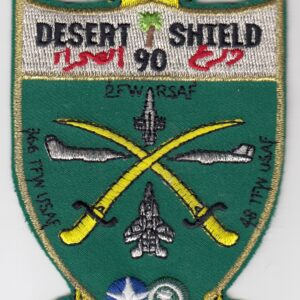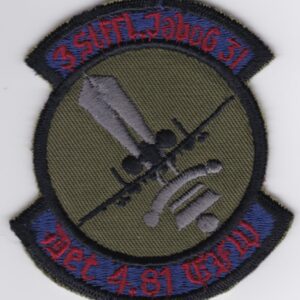Your cart
USAF Patch Fighter USAFE b 48 TFW Tactical Fighter Wing F 111 o Deployed 1986 Libya c
$26.99
USAF 48 TFW Fighter Patch USAFE Tactical Fighter Wing Raiders Libya 1986 F 111 RAF Lakenheath Second issue PM Asian embroidered on twill cut edge 96mm by 93mm three and three quarter inches by three and three quarter inches
USAF 48 TFW Fighter USAFE
Free Shipping
History
On April 14 at 17 36 GMT 24 F 111E Aardvarks of 48 Tactical Fighter Wings 492 493 and 494 Tactical Fighter Squadrons departed from RAF Lakenheath with the intent that six would return after the first refuelling about 90 minutes out. At the same time five EF 111A electronic warfare aircraft of 42 Electronic Combat Squadron ECS of 20 Tactical Fighter Wing TFW took off from RAF Upper Heyford To save time and ease navigation a Tanker Force of 19 KC 10s from Barksdale AFB themselves refuelled by 10 KC 135s from 300 Strategic Wing RAF Mildenhall and 11 Strategic Group RAF Fairford were to accompany the F 111s on the attack.
At the first refuelling six F 111Fs and one EF 111A broke off and returned to base. France Germany Italy and Spain although affected by Libyan trained supplied and supported terrorist attacks refused to cooperate in a strike and the USAF attack force navigated around France and Spain through the airspace over the narrow Strait of Gibraltar and then eastward over the Mediterranean until in a position to attack. This represented a gruelling round trip flight of 6400 miles over 13 hours requiring eight to 12 inflight refuelling tasks for each F 111 aircraft as opposed to the standard trained for NATO F 111 sortie of about two hours and placed a tremendous strain on crews and complex avionic systems of the aircraft.
The US Navys Sixth Fleet was to attack with the forces arrayed on two carriers. USS Coral Sea launched eight A 6E medium bombers for the attack and six FA 18C Hornets for strike support. USS America launched six A 6Es for the attack and six A 7Es and an EA 6B for strike support. F 14 Tomcat fighters protected the fleet and aircraft.
Libyas air defence system was sophisticated and its operators were acutely aware that an attack was coming. At about midnight GMT six flights of three F 111Fs each bore down on Tripoli. The first three attacking elements code named Remit Elton and Karma were tasked to hit Qaddafi’s headquarters and command and control center at the Azziziyah Barracks. Only two of the nine aircraft dropped their bombs. Another element codenamed Jewel successfully struck the Sidi Balal terrorist training camp where there was a main complex and academy a Palestinian training camp and a maritime academy under construction. Two further elements Puffy and Lujac struck Tripoli airport with 500 pound bombs destroying and damaging a number of aircraft. 42 ECS EF 111As and Navy A 7s A 6Es and an EA 6B provided defence suppression support over Triploi using HARM and Shrike anti radar missiles. While all three targets had been successfully struck only four of the 18 F 111s dropped successfully with 6 forced to abort due to aircraft difficulties or stringencies of the Rules of Engagement 7 missed their targets and one was lost. The F 111Fs spent only 11 minutes in the target area with anti aircraft and SAM opposition from the outset confirming that the Libyans were ready. One aircraft Karma 52 was lost almost certainly due to a SAM.
In the Gulf of Sidra Navy A 6E aircraft attacked the Al Jumahiriya Barracks at Benghazi and the Benina airfield with Navy A 7s A 6Es FA 18s and an EA 6B provided defence suppression support.
News of the raid was broadcast while it was in progress. On the return leg one F 111F had to divert to Rota AB Spain because of an engine overheat.
President Ronald Reagan ordered a strike on Libya following a buildup of Libyan state sponsored terrorism including providing support to Abu Nidal aircraft hijackings lethal attacks at Rome and Vienna airports praised by Gaddafi as heroic acts bombing of the Marine Barracks in Beirut and Libyas self declared ownership of international waters in the Gulf of Sidra and its imposition of Gaddafis Line Of Death where foreign shipping and aircraft would be attacked by Libya if the line was crossed. The US Navys Mediterranean based Sixth Fleet Aircraft Carriers began a series of manoeuvres designed to continue freedom of navigation across the line and on 29 March 1986 SAMs were fired at Navy aircraft escorting a Libyan Mig 25 with the Navy responding with attacks on the SAM sites and Libyan Navy attack vessels. On 2 April 2 1986 a terrorists bomb exploded on TWA Flight 840 flying above Greece with four Americans killed and on 5 April 1986 a bomb exploded in Berlins La Belle Discotheque frequented by US military personnel resulting in two American servicemen killed and 79 Americans injured. Three terrorist groups claimed responsibility for the bomb but the United States and West Germany independently announced incontrovertible evidence that Libyans were responsible for the bombing.
The months following the strike saw a dramatic decrease in the number of Libyan sponsored anti American terrorist events. The Red Army Faction one of the groups that had claimed responsibility for the La Belle disco bombing reduced its activities and other Libyan sponsored groups followed suit although the bombing Pan American Flight 103 over Lockerbie Scotland on 21 December 1988 killing 270 turned out to be directed by Libya.
This patch dates from 1986.
You may also like…
-

USAF Patch Fighter USAFE b 48 TFW Tactical Fighter Wing F 111 o Deployed 1986 Libya l
$29.99 Add to cart -

USAF Patch Fighter USAFE b 48 TFW Tactical Fighter Wing F 111 p Deployed 1990 Iraq b
$37.99 Add to cart -

USAF Patch Fighter USAFE b 81 TFW Tactical Fighter Wing g A 10 Det 4 Norvenich AB e3sa
$32.99 Add to cart -

USAF Patch Fighter USAFE b 48 TFW Tactical Fighter Wing F 111 p Deployed 1990 Iraq a
Read more -

USAF Patch Fighter USAFE b 48 TFW Tactical Fighter Wing F 111 p Deployed 1991 Iraq e
$24.99 Add to cart









